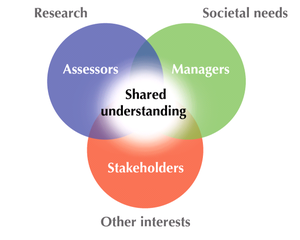Implementation plan of evidence-based policy
| Moderator:Jouni (see all) |
|
|
| Upload data
|
Scope
How can the better policy practises identified in Yhtäköyttä-project be implemented into national governance(?)? Especially actions that support the government(?) are examined.
Answer
The implementation plan includes three new social innovations, that will be taken into use in the decision preparations (?) supporting the government's work. These are a) shared understanding as a goal for information work(?), b) variables in structuring and interpreting of information and c) respect theory to motivate the production of information.

<section begin=glossary />
- Shared understanding between two individuals about a particular topic means a situation where each individual is able to correctly explain what the other thinks about the topic and why. This definition can be extended also to a larger group. Here shared understanding is a written description of the topic that covers the thinking and reasoning on the topic of all members. In this group setting, not everyone needs to be able to describe everyone else's thinking, but everyone should agree that the written description correctly contains their thinking about the topic. In this way, although not everything is known by everyone in the group, the written description effectively represents the shared understanding of the group. Importantly, online tools such as wikis can be used to develop shared understanding even about complex topics among large groups.
- It is important to notice that shared understanding is not the same as consensus or agreement. In shared understanding people can still disagree on the topic, but they agree on what opinions there are about it. While the purpose of agreement in decision-making is to conclude about the best option and act based on it, the purpose of shared understanding is to identify one or more poor decision option that should be rejected. This is analogous to the scientific method. Instead of attempting to find the truth directly, it critically evaluates hypotheses and rejects all that are not plausible in the light of observations. As the scientific method has proved to be the best method known for developing knowledge about the world, shared understanding may prove to be an effective way to make public policy.
<section end=glossary />
In decision preparation (?) using shared understanding for example in drafting a bill it is not enough, that a law text (?) with is created with valid arguments. It must also be described, what other points of views there were and what were their arguments. Even views that were once suggested seriously but that turned out to be invalid will be described; this is important so they don't resurface when people not familiar with the work earlier in the preparations join the work. This could also be important to acceptability to the public and other who were never a part of the preparations.
To make describing the shared understanding practically possible, the law preparations will need a new, open webworkspace. It can be fully open (in the internet) or if the situation requires only open to those participating in the preparations. From the point of view of trying out the method completely open preparation would be the most educational.
Additionally the work must be targeted, meaning all separate thing has their own page in the workspace, and all connected material is gathered on the page no matter who produced the information. The research question is precisely defined, and the purpose of the work is to produce the best possible answer to it. This means a transfer from a person-based information structure to a topic-based information structure. This way everyone participating in the preparation will have at hand the same information and tools and are capable of evaluating, what information is still missing from the goal of shared understanding. The schedule and to-do-list for the project will also be open, so following the case is made easier. Separate to-do-lists are avoided, because they make it harder for the information to spread.
Thus the goal of shared understanding creates the following action proposition:
- Action 1. Shared understanding is taken as a spelled out goal in the projects that want to use the implementation plan.
- Action 2. The preparations for the projects are done in an open webworkspace. The existing tools can still be used, but all information will be brought alto to the worspace without delay.
- Action 3. The information is structured in the workspace by topic and research questions for each topic are defined
- Action 4. The person in change of the project opens the schedule and to-do-list of the project for everyone to see and maintains it for the durations of the project.